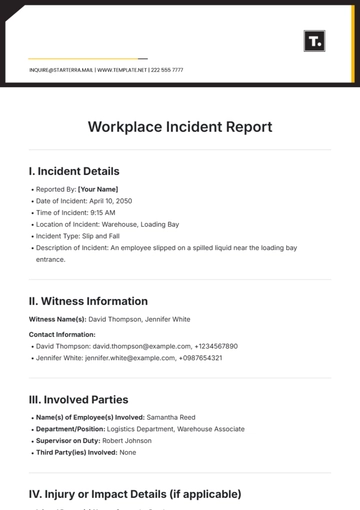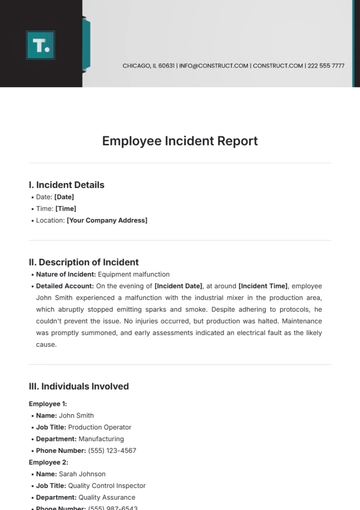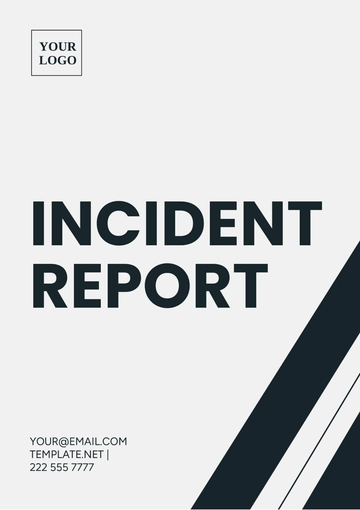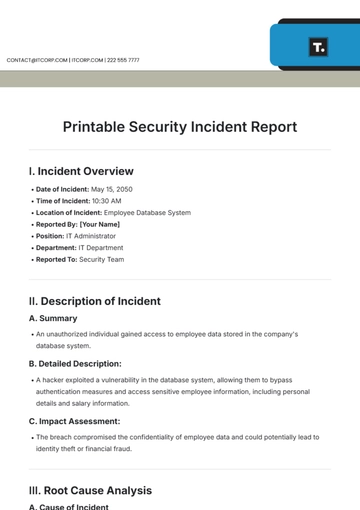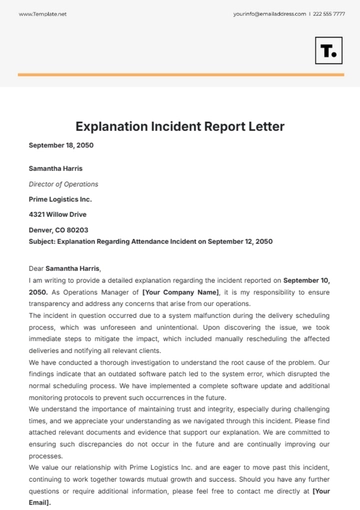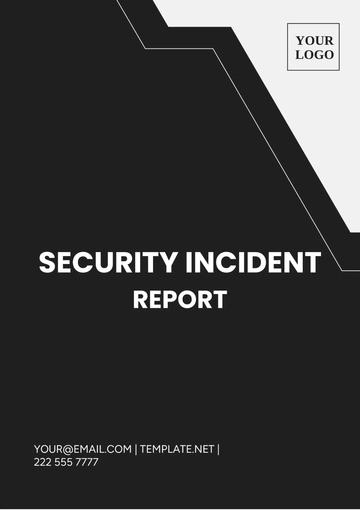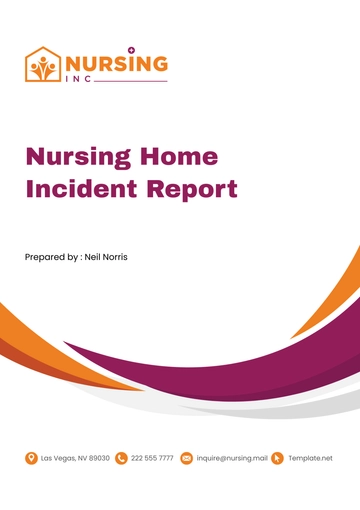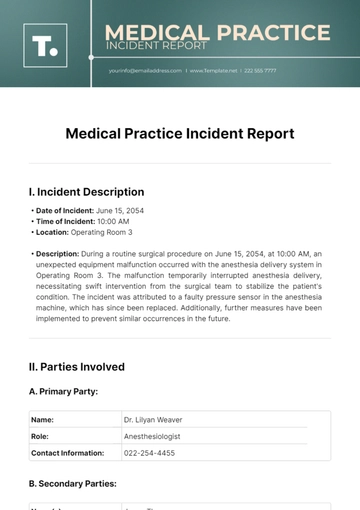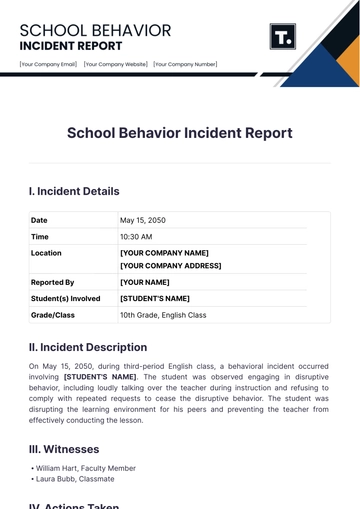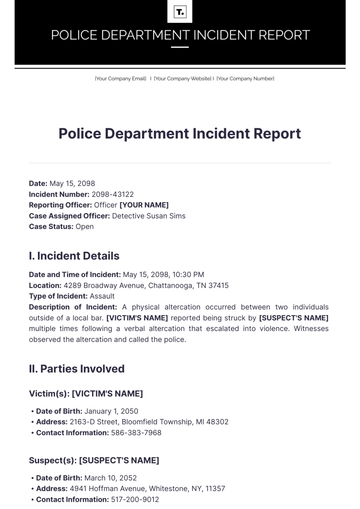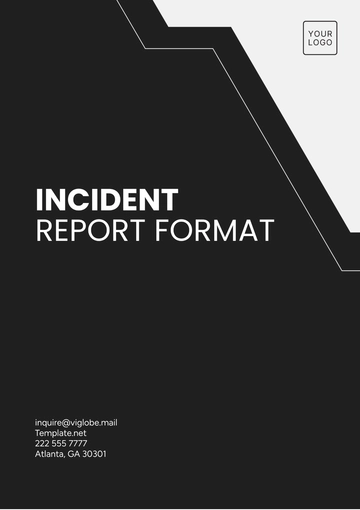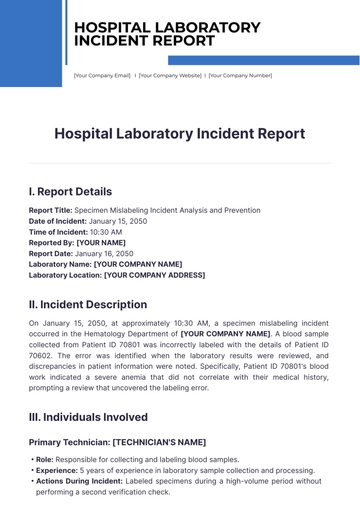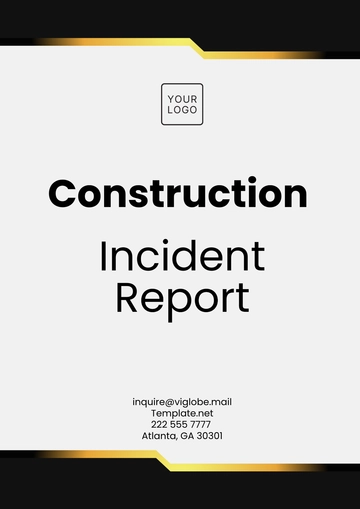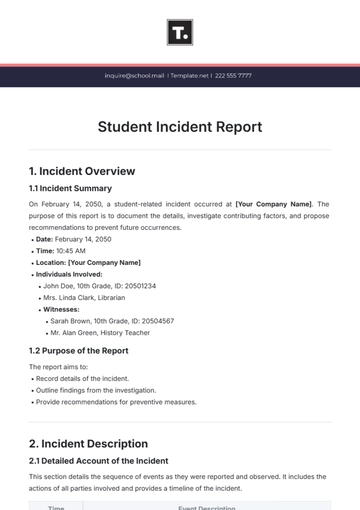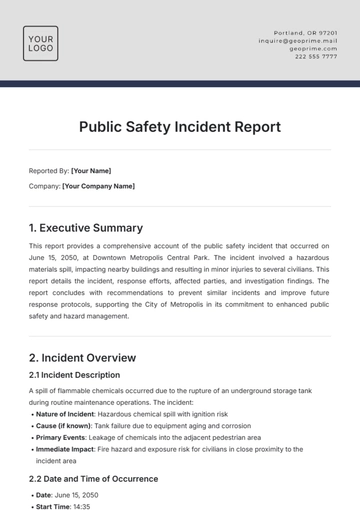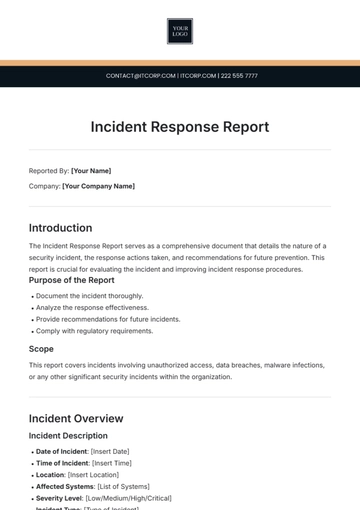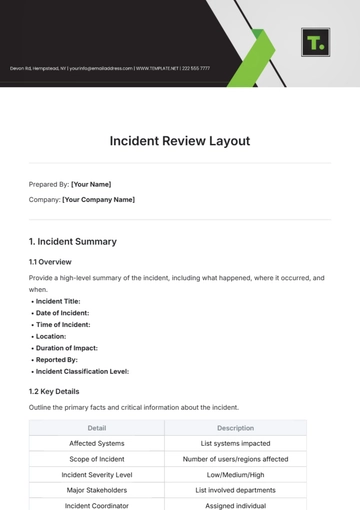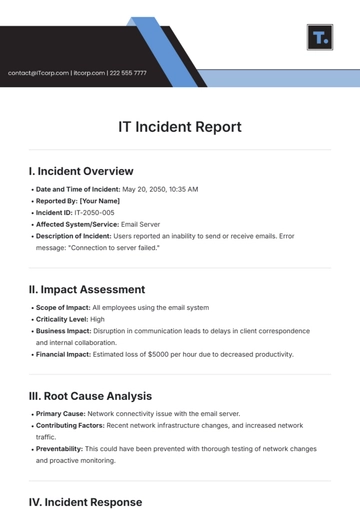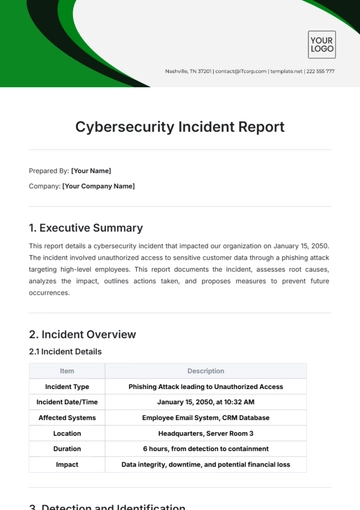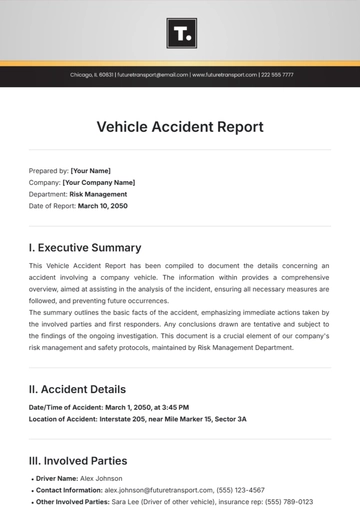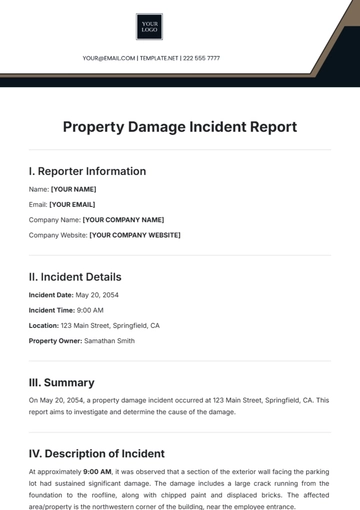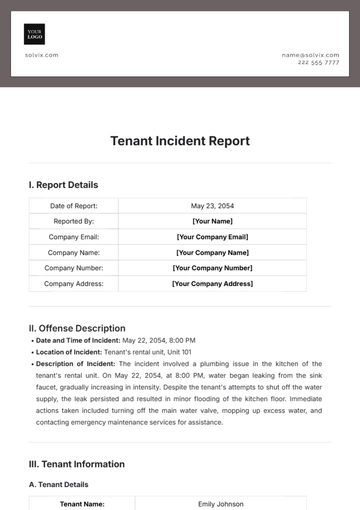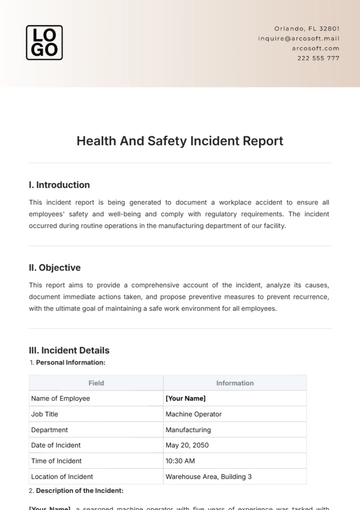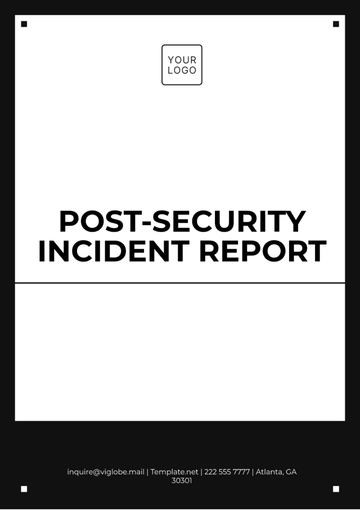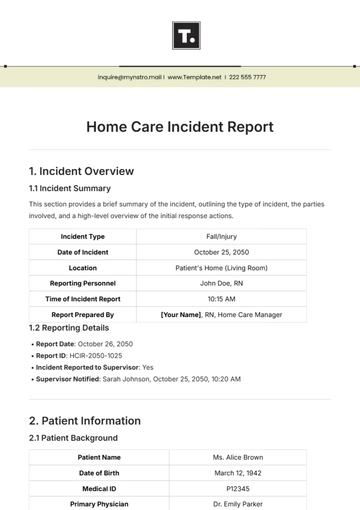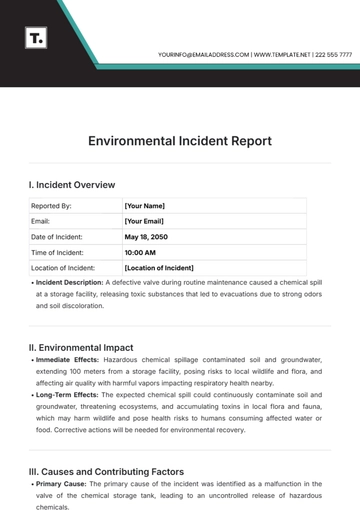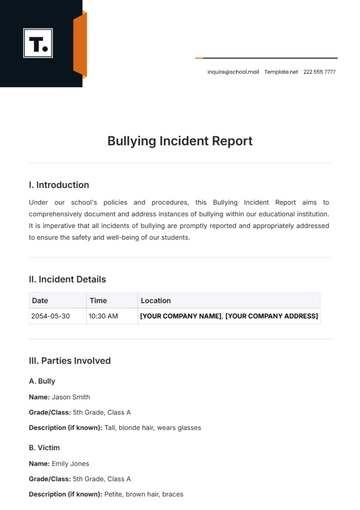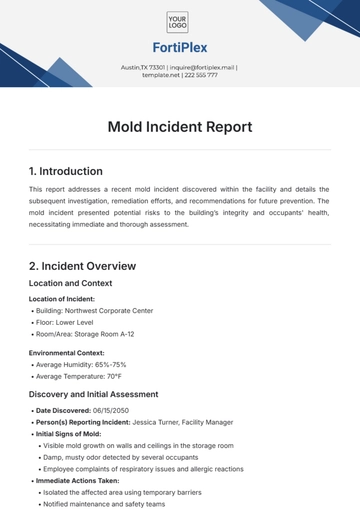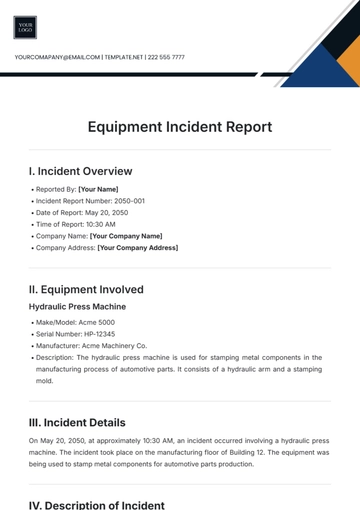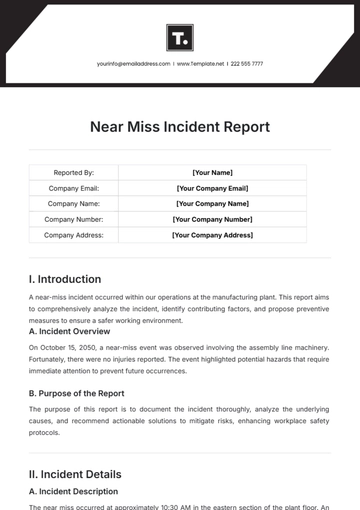Free Defense Incident Report
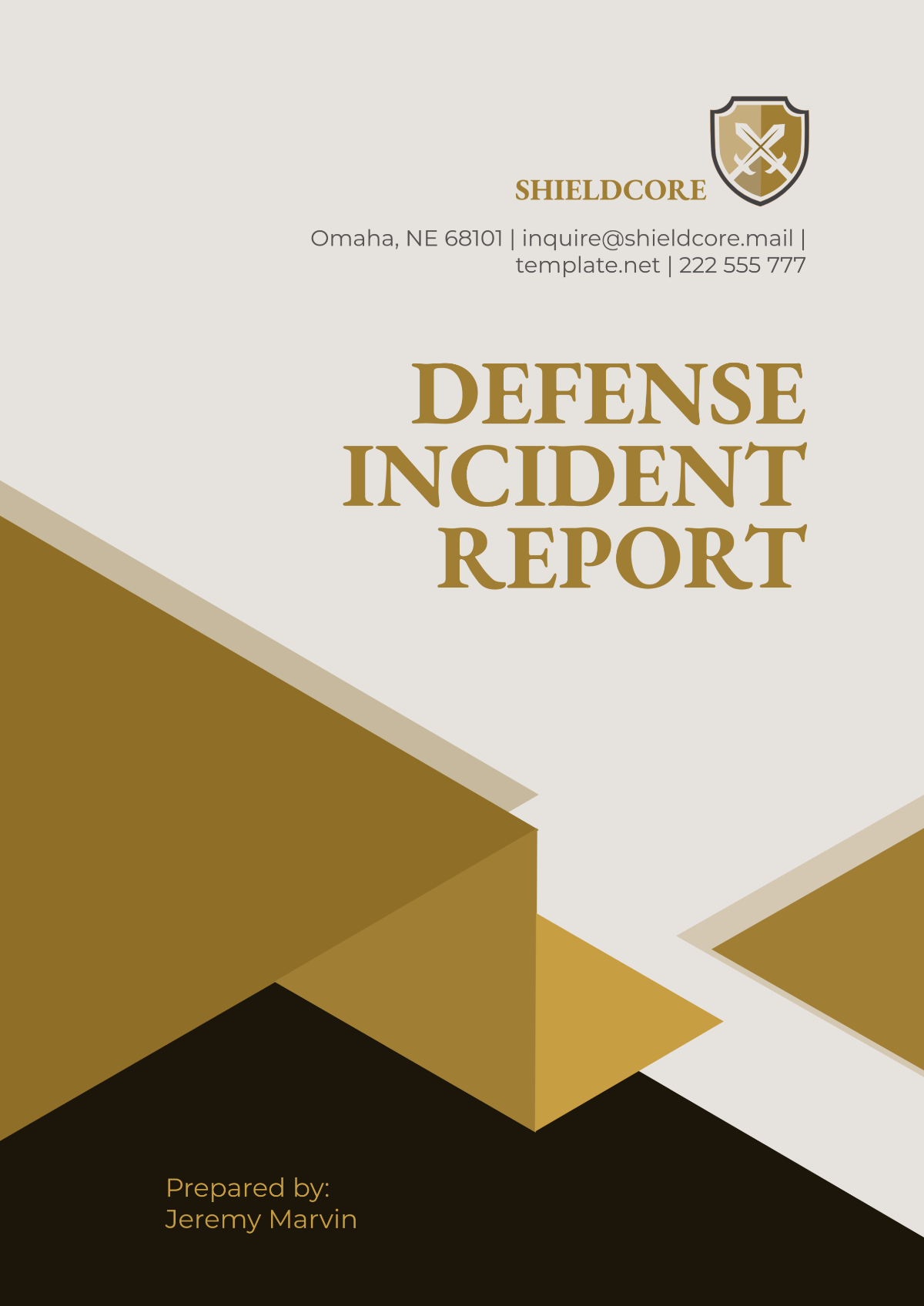
I. Executive Summary
A. Purpose of the Report
This Defense Incident Report (DIR) is being submitted to document the breach of our secure communications infrastructure that occurred on January 5, 2050. The incident was detected by our monitoring systems, and immediate actions were taken to contain and mitigate its impact. The purpose of this report is to provide an in-depth analysis of the incident and outline preventive measures for future security improvements.
B. Overview of the Incident
At 0230 hours on January 5, 2050, an unauthorized access attempt was detected on the secure communications server located at the [Company Facility Address]. The breach was made possible through a previously unknown vulnerability in the firewall, which allowed external actors to gain temporary access to sensitive data. Within 45 minutes, the breach was contained, and external access was severed, but data was accessed, including sensitive information on military contracts.
C. Key Findings and Recommendations
Initial findings suggest that outdated security protocols and a failure to implement recent patches were major contributors to the breach. Human error played a role, as certain network monitoring alerts were overlooked, delaying the initial response. Recommendations include a complete review and update of our cybersecurity policies, increased system patching schedules, and comprehensive cybersecurity training for all personnel.
II. Incident Details
A. Date and Time of Incident
The incident took place on January 5, 2050, at approximately 0230 hours when an unauthorized access attempt was first detected by the internal security systems. The breach was fully contained by 0315 hours, when external access was blocked and systems were isolated. The response time was rapid, minimizing the potential for further data loss.
B. Location of Incident
The breach occurred at the [Your Company Name] secure communications facility located at [Company Facility Address]. This facility houses critical defense infrastructure used for secure communications, including contracts with military agencies. Access to this facility is restricted to personnel with high security clearances, and any breach poses a direct threat to national security.
C. Type of Incident
The incident is classified as a cybersecurity breach involving unauthorized access to sensitive communications data. The breach targeted encrypted data related to military contracts, though no classified information was leaked externally. The attack exploited a vulnerability in the Firewall X-1000 Security Gateway, which had been scheduled for an update but had not yet been patched.
D. Incident Discovery
The breach was first discovered by our Network Monitoring System (NMS) at 0232 hours, which flagged an unusual data transmission pattern coming from an external IP address. Upon further investigation, it was determined that the firewall's security protocols were bypassed, granting temporary unauthorized access. The security team was notified at 0235 hours, and a full incident response protocol was immediately initiated.
III. Parties Involved
A. Personnel Involved
[Security Officer Name] (Lead Investigator) | Oversaw the investigation, secured the affected systems, and coordinated communication efforts during the incident response. |
[Network Administrator Name] (Network Administrator) | Managed the isolation of the affected communication systems, reconfigured firewalls, and ensured system integrity. |
[IT Specialist Name] (IT Specialist) | Assisted with the forensic analysis of the breached data, identified the vulnerability in the firewall, and collaborated with external experts. |
B. External Parties
While no external individuals were directly involved in the breach, [Firm Name], an independent cybersecurity consulting firm, was contacted for a third-party review of the incident. [Firm Name] provided additional insight into the security failure and recommended updates to the existing systems. The company’s internal review will also include external security experts to ensure comprehensive prevention measures.
C. Equipment and Resources Affected
The primary systems affected were the [Server Name] and the Firewall X-1000 Security Gateway, which are both critical components of our secure communications infrastructure. Additionally, the encrypted database containing sensitive contract information was accessed, although the data was encrypted and was not fully compromised. All affected systems have been secured and are undergoing further security reviews.
IV. Event Chronology
Time | Event Description |
|---|---|
0230 hours | Initial breach attempt detected by network monitoring system. |
0232 hours | IDS flags unusual data transmission pattern from external IP. |
0235 hours | Incident escalated to security team, investigation begins. |
0300 hours | Unauthorized access blocked, external IP address blacklisted. |
0315 hours | Full system restoration completed, incident resolved. |
A. Sequence of Events
The breach began at 0230 hours when the monitoring system detected unusual data transmissions. By 0232 hours, it was confirmed that unauthorized access was granted via a vulnerability in the firewall, which allowed external parties to temporarily bypass security measures. By 0300 hours, the access was blocked, and the affected systems were isolated to prevent further damage.
B. Actions Taken
Upon discovering the breach, the first action was to sever the compromised systems from the rest of the network. The Firewall X-1000 was reconfigured, and the affected communication server was temporarily taken offline to prevent further data exfiltration. A notification was sent to senior management, and an emergency response team was assembled to handle the ongoing investigation.
C. Incident Escalation
As the breach was confirmed, the incident was escalated to higher security levels. External cybersecurity consultants were called in to assist with advanced forensics and vulnerability assessments. Additionally, a full audit of all network access protocols was initiated to prevent future breaches.
V. Root Cause Analysis
A. Initial Findings
The breach was traced back to a vulnerability in the Firewall X-1000, which had not been patched due to an oversight during routine maintenance. The vulnerability allowed an external actor to bypass initial security protocols and gain access to the internal network. Further forensic analysis confirmed that no unauthorized data was exfiltrated beyond the secure network perimeter.
B. Contributing Factors
Human error contributed significantly to the incident, particularly in the failure of the monitoring team to notice early warning signs of abnormal activity. Additionally, the lapse in patching the firewall software created a window of opportunity for the breach to occur. There was also a delay in escalating the issue, as the network monitoring team did not immediately recognize the seriousness of the initial alert.
C. Impact of the Cause on the Outcome
The firewall’s failure allowed the attackers access to sensitive data, but due to the quick containment efforts, no classified information was leaked. Had the breach remained undetected for longer, it could have resulted in the unauthorized extraction of highly sensitive defense contracts, posing a significant threat to national security.
VI. Consequences of the Incident
A. Damages and Losses
No physical damages were incurred; however, access to sensitive data related to upcoming defense contracts was gained. Though the data was encrypted and not leaked, the potential security risks associated with the breach could have far-reaching consequences. The direct financial cost of addressing the breach, including system upgrades and forensic analysis, is estimated at $[00].
B. Operational Disruptions
There was a brief disruption in communications for a 45-minute window, which impacted internal coordination and response times. The breach also delayed the execution of some ongoing military contracts, though all projects were able to continue within 24 hours. The breach served as a reminder of the vulnerabilities that exist in even the most secure systems.
C. Security or Safety Risks
While the breach posed a risk to the confidentiality of military contracts, no data was leaked. However, the incident highlighted the potential risks to national security, especially in the context of upcoming defense contracts that could have been intercepted or altered by unauthorized actors. There remains a heightened risk for future attacks.
VII. Corrective and Preventative Actions
A. Immediate Corrective Actions Taken
The firewall vulnerability was immediately patched, and the affected communication server was re-secured. Temporary access measures were put in place to prevent any further intrusions while the affected systems underwent a full forensic investigation. Security protocols were reviewed, and system configurations were updated to reflect best practices.
B. Long-Term Preventative Actions
A complete overhaul of the company’s security infrastructure is planned, with particular emphasis on implementing redundant security systems and regular software patching cycles. The company will also invest in more robust monitoring systems to detect anomalies more effectively. Additionally, an incident response team will be put in place to handle similar incidents in the future.
C. Training or Awareness Programs
An intensive, company-wide cybersecurity training program will be rolled out within the next 60 days. This training will focus on recognizing and mitigating threats such as phishing, social engineering, and insider threats. Furthermore, the IT department will receive specialized training on vulnerability management and real-time system monitoring.
VIII. Follow-Up Actions
A. Ongoing Investigations
Following the containment of the breach, a thorough internal investigation is underway to assess the full scope of the incident and its impact on our systems. The investigation includes a detailed review of the Firewall X-1000 configuration, along with an audit of all associated network access logs to identify any additional vulnerabilities. Collaboration with external cybersecurity consultants has been initiated to ensure that all aspects of the breach are investigated thoroughly and that any lingering threats are mitigated.
B. Audits and Evaluations
A comprehensive cybersecurity audit will be conducted over the next 30 days to evaluate the strength of our existing network infrastructure and identify any weaknesses in our current defense systems. The audit will include penetration testing to simulate potential future attacks and ensure that all vulnerabilities are addressed before they can be exploited. Additionally, an evaluation of our disaster recovery and business continuity plans will be conducted to confirm that we are fully prepared for any future incidents.
C. Reporting to Higher Authorities
As part of compliance with national security regulations, a detailed report of the breach and the actions taken has been submitted to the Department of Defense and other relevant governmental bodies. The report includes an analysis of the incident, the immediate response, and corrective actions taken to mitigate future risks. We are committed to cooperating fully with all authorities to ensure transparency and accountability, and to aid in any ongoing investigations related to the breach.
IX. Conclusion
A. Summary of Findings
The breach was caused by a combination of human error and outdated cybersecurity protocols, specifically the unpatched vulnerability in the Firewall X-1000. Despite the vulnerability, quick detection and a swift response by the internal security team prevented any sensitive data from being compromised. The incident highlighted several weaknesses in our cybersecurity practices, including inadequate patch management and a lack of proactive monitoring for potential threats.
B. Final Recommendations
To prevent future incidents, it is recommended that we implement a more rigorous schedule for software updates and security patches, with a dedicated team to monitor and enforce compliance. Strengthening network monitoring tools and enhancing anomaly detection capabilities will help ensure earlier identification of potential threats. Additionally, revising our incident response protocol to include regular drills and real-time simulations will better prepare staff for future security breaches.
C. Acknowledgments
Special thanks are due to the [Security Officer Name] for their leadership during the crisis, and to the [Network Administrator Name] for their quick actions in containing the breach. The [IT Specialist Name] was instrumental in performing the forensic analysis, uncovering the root cause of the incident. Finally, external cybersecurity consultants provided invaluable expertise in evaluating our response and helping refine our security strategy.
- 100% Customizable, free editor
- Access 1 Million+ Templates, photo’s & graphics
- Download or share as a template
- Click and replace photos, graphics, text, backgrounds
- Resize, crop, AI write & more
- Access advanced editor
Submit your Defense Incident Report seamlessly with the customizable template from Template.net. This editable report template is designed for easy use, allowing you to tailor the content to your specific needs. With the advanced AI Editor Tool, you can refine every section for accuracy and professionalism, ensuring your reports are both thorough and efficient.
You may also like
- Sales Report
- Daily Report
- Project Report
- Business Report
- Weekly Report
- Incident Report
- Annual Report
- Report Layout
- Report Design
- Progress Report
- Marketing Report
- Company Report
- Monthly Report
- Audit Report
- Status Report
- School Report
- Reports Hr
- Management Report
- Project Status Report
- Handover Report
- Health And Safety Report
- Restaurant Report
- Construction Report
- Research Report
- Evaluation Report
- Investigation Report
- Employee Report
- Advertising Report
- Weekly Status Report
- Project Management Report
- Finance Report
- Service Report
- Technical Report
- Meeting Report
- Quarterly Report
- Inspection Report
- Medical Report
- Test Report
- Summary Report
- Inventory Report
- Valuation Report
- Operations Report
- Payroll Report
- Training Report
- Job Report
- Case Report
- Performance Report
- Board Report
- Internal Audit Report
- Student Report
- Monthly Management Report
- Small Business Report
- Accident Report
- Call Center Report
- Activity Report
- IT and Software Report
- Internship Report
- Visit Report
- Product Report
- Book Report
- Property Report
- Recruitment Report
- University Report
- Event Report
- SEO Report
- Conference Report
- Narrative Report
- Nursing Home Report
- Preschool Report
- Call Report
- Customer Report
- Employee Incident Report
- Accomplishment Report
- Social Media Report
- Work From Home Report
- Security Report
- Damage Report
- Quality Report
- Internal Report
- Nurse Report
- Real Estate Report
- Hotel Report
- Equipment Report
- Credit Report
- Field Report
- Non Profit Report
- Maintenance Report
- News Report
- Survey Report
- Executive Report
- Law Firm Report
- Advertising Agency Report
- Interior Design Report
- Travel Agency Report
- Stock Report
- Salon Report
- Bug Report
- Workplace Report
- Action Report
- Investor Report
- Cleaning Services Report
- Consulting Report
- Freelancer Report
- Site Visit Report
- Trip Report
- Classroom Observation Report
- Vehicle Report
- Final Report
- Software Report
